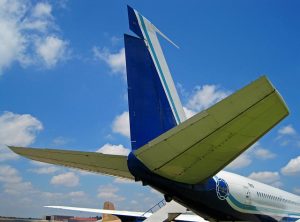
Not all airplanes have fixed, unmovable tail assemblies. Whether it’s a small Cessna 172 or a jumbo-sized Airbus A380, it will likely have two horizontally hinged surfaces known as elevators. Here are six facts about elevators and how they work.
#1) Used to Control Pitch
Elevators are used to control the pitch of an airplane. Along with roll and yaw, pitch is one of the three dimensions of rotation in airplanes. Also known as the lateral axis, pitch involves the rotation of an airplane around its side-to-side axis. Pilots can raise or lower the airplane’s elevators to change its pitch.
#2) Affects Altitude
Because they are used to control the pitch of an airplane, elevators affect altitude. The nose of the airplane will point up or down depending on the position of the elevators. When the elevators are raised, for instance, the nose of the airplane will point up, resulting in an increase in altitude. When the elevators are lowered, the nose of the airplane will point down, resulting in a decrease in altitude.
#3) May Be Integrated Into a Stabilator
While most airplanes have two separate elevators on their tail assembly, some of them have a stabilator, instead. A stabilator is an all-moving horizontal stabilizer. It incorporates the elevators into a single, moving flight control surface. Military jets often have a stabilator instead of traditional elevators. With a stabilator, military jets benefit from reduced drag at high-Mach speeds.
#4) Increase or Decrease Downward Force
Elevators operate on the principle of increasing or decreasing downward force, which in turn changes the airplane’s pitch. Raising the elevators, for instance, will increase the downward force so that the nose points up. Lowering the elevators, on the other hand, will decrease the downward force so that the nose points down.
#5) Affects Angle of Attack
The main purpose of elevators is to control the pitch of an airplane. However, elevators will also affect the airplane’s angle of attack. Angle of attack (AOA) is the chord of the wings relative to the wind. Pilots must carefully consider the AOA because it will affect the airplane’s stability and overall performance.
#6) Electronically Controlled
In the past, elevators were controlled mechanically. Some airplanes still use mechanically controlled elevators, but many of them have since switched to electronically controlled elevators. These electronically controlled elevators are part of the airplane’s fly-by-wire system.



